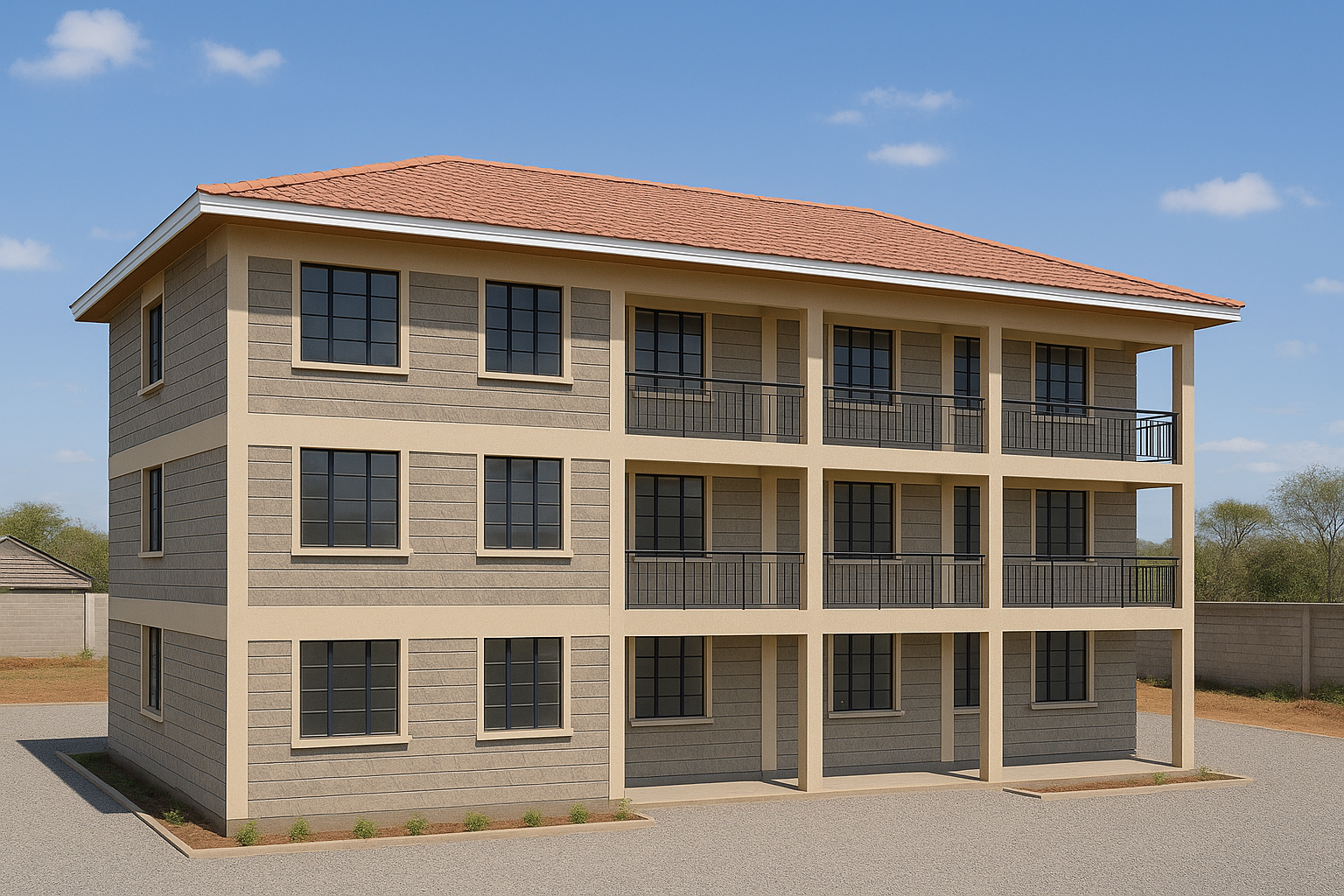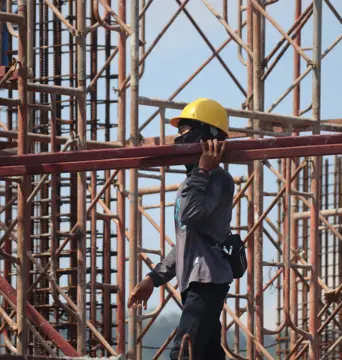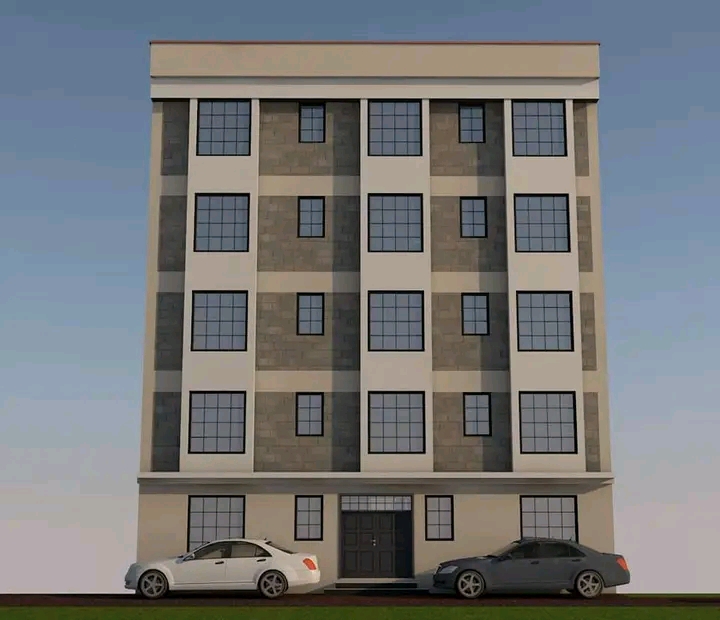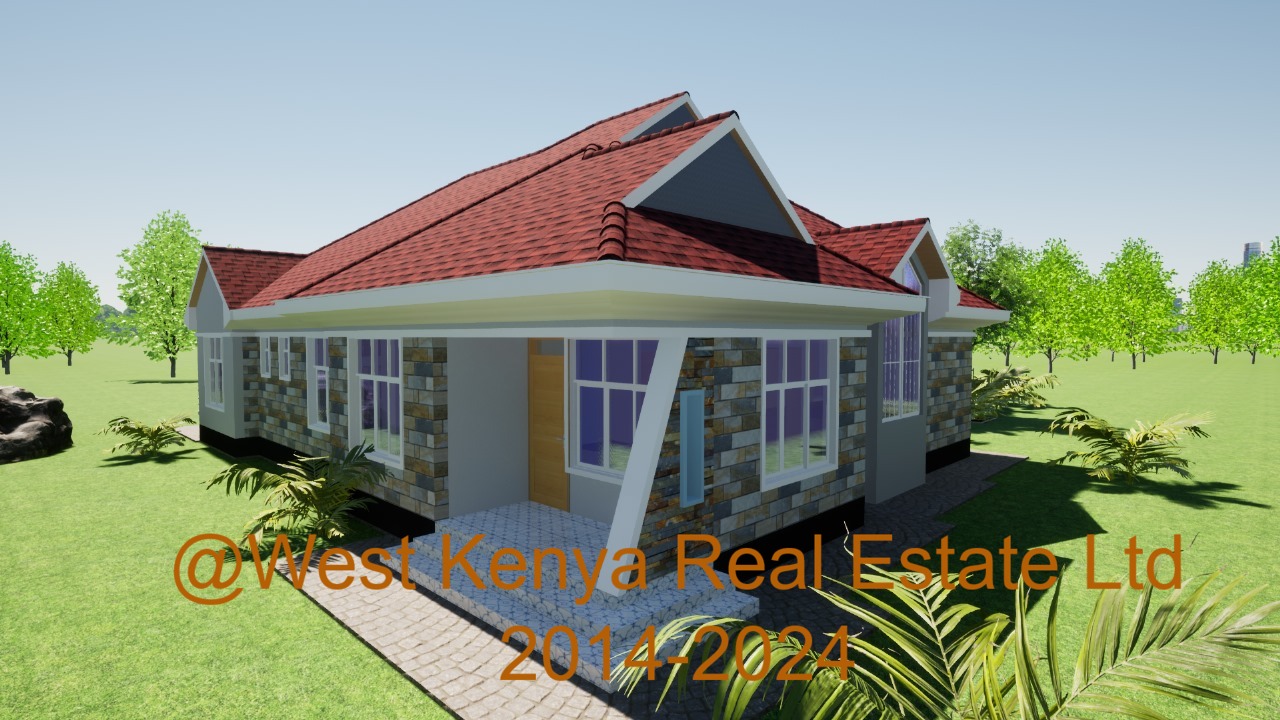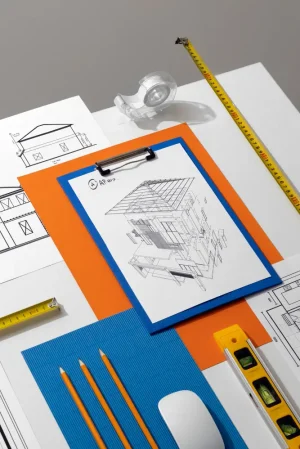1. Introduction
Kenya’s real estate sector continues to expand, with a growing focus on affordable rental housing to meet the rising demand in urban and peri-urban areas. With increasing rural-to-urban migration, a youthful population, and expanding middle- and lower-income brackets, there is a consistent need for well-designed, affordable apartment units. Developers and investors are quickly realizing the potential of tapping into this market segment, especially in counties like Nairobi, Kisumu, Nakuru, Machakos, and Kiambu.
One of the most strategic investment ranges for such developments is between Ksh 30 million and Ksh 50 million. This budget range offers a balance between manageable construction costs and meaningful rental income returns. It allows investors to develop modest yet high-yield apartment projects—typically low-rise buildings with 1–3 bedroom units that are ideal for workers, small families, and students.
To succeed in this space, developers must adopt smart, efficient apartment designs that optimize available land, minimize waste, and meet tenant expectations without overshooting the budget. The goal isn’t just to build—but to build affordably and profitably.
In this article, we explore the best apartment designs in Kenya under 50 million, offering insights on layouts, cost breakdowns, and return on investment potential. Whether you’re a first-time developer or a seasoned investor, these plans can help you maximize your earnings while addressing the country’s affordable housing gap.

Related post: Top 600 Sq Ft Apartment Plans for 2 Bedroom Rentals in Kenya
2. What Makes an Apartment Design “Affordable” in Kenya?
An “affordable” apartment design in Kenya goes beyond just reducing the initial construction cost—it’s about achieving the right balance between functionality, durability, and long-term value. Typically, affordable apartment buildings are designed to use moderate floor areas, locally available construction materials, and basic but neat interior finishes that meet tenant expectations without inflating costs.
For example, floor plans are often compact and efficient—featuring bedsitters, one-bedroom, or two-bedroom units with shared amenities such as staircases, balconies, and common utility areas. Materials like stabilized soil blocks, precast concrete panels, and steel trusses with mabati roofing are commonly used to keep expenses low while maintaining structural integrity. Interior finishes such as ceramic tiles, MDF cabinetry, and simple sanitary fittings are favored for their cost-effectiveness and ease of replacement.
Affordability also ties directly into sustainability and long-term maintenance costs. A well-designed, affordable apartment should have good natural lighting, adequate ventilation, and water-efficient plumbing systems. These features reduce ongoing utility bills and enhance tenant comfort. Additionally, choosing materials that are easy to clean and maintain helps reduce repair costs over time.
One of the most critical factors influencing affordability is location. In urban areas like Nairobi and Mombasa, land prices and approval fees are high, making it more expensive to build. However, peri-urban and satellite towns such as Kitengela, Ruiru, Kisumu’s outskirts, or Nakuru’s new residential zones offer more affordable land and construction costs. Rural areas may offer the lowest land costs, but developers must consider potential lower rental demand and infrastructure limitations.
Related post: Ksh 200 Million Apartment Design in Maguga, Kiambu County: A Mixed-Unit Investment Opportunity
Ultimately, achieving affordability means designing with intention—prioritizing value over luxury, and ensuring every square meter serves a purpose. The right apartment design in the right location can deliver strong rental yields while remaining within a Ksh 30–50 million budget.
3. Understanding the Cost Breakdown for Building Apartments in Kenya
Before starting any apartment project, it’s essential to understand where your money goes. In Kenya, the average construction cost for standard apartments ranges between Ksh 35,000 to Ksh 55,000 per square meter, depending on the design, location, materials, and finishes. This translates to roughly Ksh 1.8M to Ksh 2.5M per unit for simple bedsitters or 1-bedroom units, and Ksh 2.5M to Ksh 4.5M per unit for larger 2- or 3-bedroom units.
A Ksh 50 million budget must be planned carefully to accommodate all major components of the project. Here’s a sample allocation breakdown:
- Land acquisition – 20% (Ksh 10M)
- Architectural, structural, and MEP designs + approvals – 5% (Ksh 2.5M)
- Construction (labour + materials) – 60% (Ksh 30M)
- Site infrastructure (parking, drainage, fencing, water tanks) – 7% (Ksh 3.5M)
- Contingency and project management – 8% (Ksh 4M)
The key cost drivers include:
- Land prices, which vary significantly by location
- Building materials, whose prices are sensitive to inflation and transport
- Labour costs, which are generally cheaper in rural or peri-urban settings
- Professional and government approvals, including NCA, NEMA, county plans, and title transfers
To stay within budget, developers can apply several cost-saving strategies:
- Use local building materials such as machine-cut stone, stabilized soil blocks, or precast elements
- Opt for a flat roof design, which is cheaper and faster to construct than pitched roofs
- Keep layouts simple and repetitive to save on structural and architectural detailing
- Build in phases, starting with a section of the units to manage cash flow and test rental demand
Careful budgeting and choosing efficient construction methods allow developers to complete functional, quality apartments under Ksh 50M without compromising on tenant appeal or long-term performance.
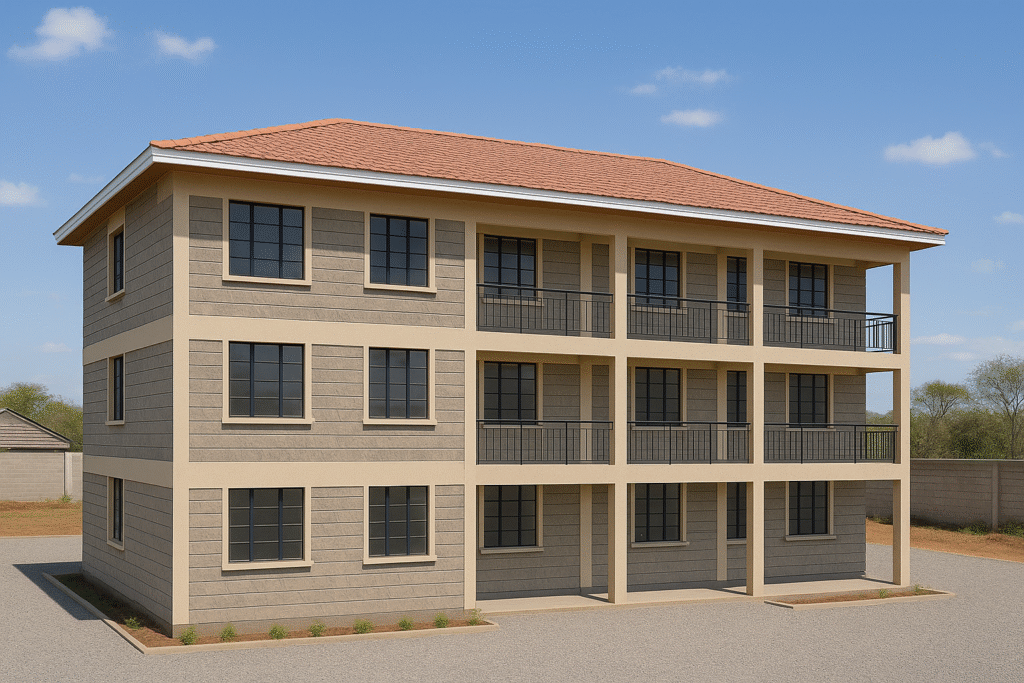
Related post: 1 & 2-Bedroom Apartment Designs That Sell Fast in Ruaka
4. Top 3 Apartment Designs in Kenya Under 50 Million
a. Design 1: 2-Storey, 8-Unit 2-Bedroom Apartment
This apartment design consists of two floors, each hosting four 2-bedroom units with a clean, symmetrical layout. Each unit typically ranges between 65–75 square meters, featuring a living room, kitchen, shared bathroom, and two spacious bedrooms—one with a wardrobe niche. The design is compact but offers comfort for small families, working couples, or civil servants.
The target tenant profile includes middle-income earners such as teachers, nurses, or junior civil servants in areas like Ngong, Ruiru, Kisumu outskirts, or Nakuru’s growing neighborhoods. The simple rectangular block allows for easy plumbing and electrical layouts, which helps in reducing overall construction costs.
The estimated construction cost for the entire block is Ksh 40–45 million, inclusive of land purchase in peri-urban zones, basic finishes, approvals, and essential site infrastructure such as parking and water tanks.
Related post: A Kshs 180 Million Apartment Design in Kikuyu, Kiambu: Studio to 3-Bedroom Investment Opportunity
Expected monthly rental income is around Ksh 18,000–25,000 per unit, depending on location. With full occupancy, this design can earn Ksh 144,000–200,000 monthly, or Ksh 1.7M–2.4M annually.
This translates to an estimated ROI (Return on Investment) of 4%–6% per year, with a payback period of 8–12 years. Maintenance costs remain moderate, and the 2-bedroom design ensures longer tenant retention compared to smaller units.
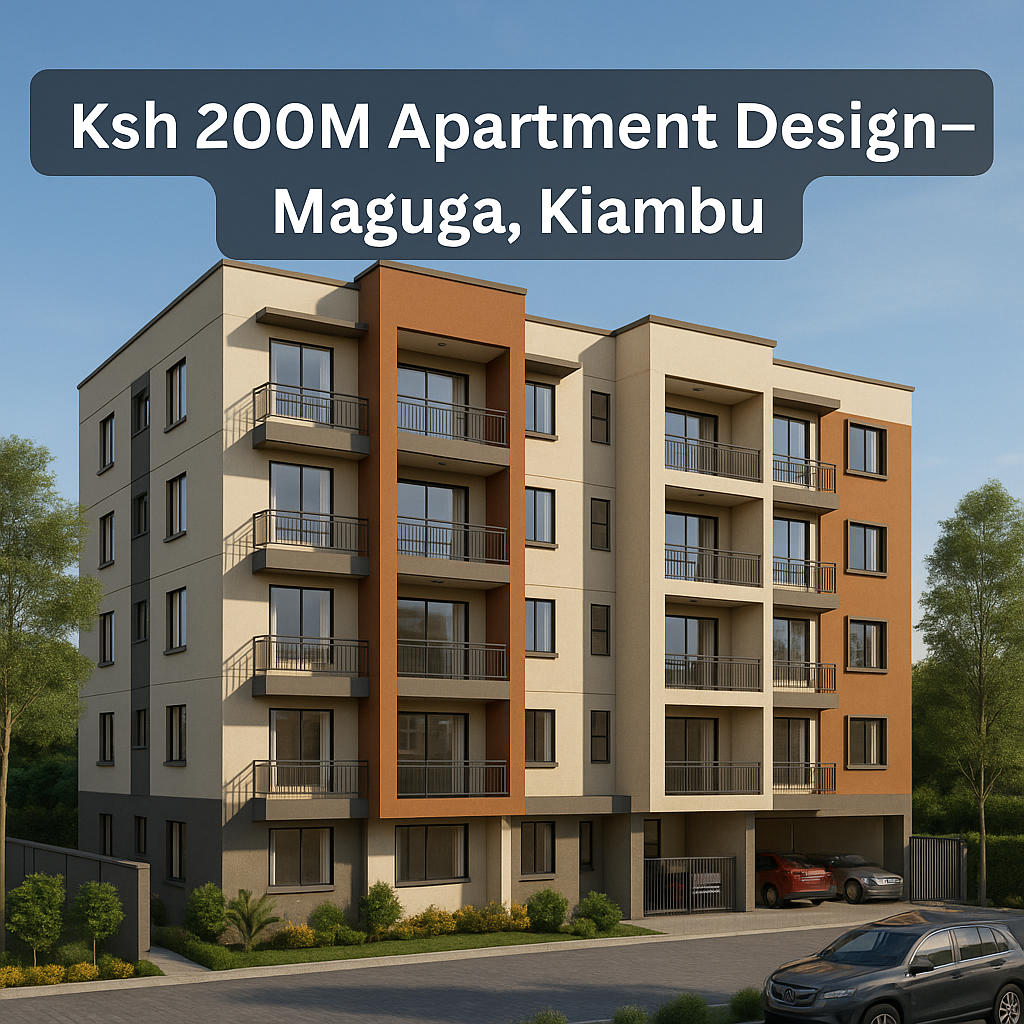
b. Design 2: 3-Storey Bedsitter + 1 Bedroom Hybrid (12–16 Units)
This layout combines affordability and density by mixing bedsitters and one-bedroom units across three floors, ideal for high-demand rental areas like university zones, industrial towns, or transport hubs. Each floor accommodates 4–5 units, with bedsitters (20–25 sqm) and 1-bedroom units (30–35 sqm) arranged side by side for maximum space efficiency.
Shared staircases, open corridors, and centralized plumbing layouts make the structure cost-effective and easy to maintain. With no lifts required and compact unit designs, this project can be built for Ksh 45–50 million, including basic site works and land in towns like Juja, Eldoret, or Machakos.
This design targets students, interns, and young professionals who prioritize affordability, safety, and access to transport and services. Tenants typically rent bedsitters at Ksh 8,000–10,000 and 1-bedrooms at Ksh 12,000–14,000 depending on location.
With 12–16 units, the building can generate Ksh 140,000–200,000 per month, translating to Ksh 1.7M–2.4M per year in gross rental income.
Given the lower construction and maintenance costs, this model has a strong ROI of 5%–7%, with a payback period of 7–10 years. Its low vacancy risk and flexible unit mix make it an excellent entry-level or portfolio-expansion project.
c. Design 3: L-Shaped 3-Bedroom Family Apartment Block (6–8 Units)
This unique L-shaped design is best suited for spacious plots or corner properties, accommodating 6 to 8 large 3-bedroom units. Each apartment spans 90–100 sqm, offering a lounge, dining area, kitchen, two bathrooms (one en suite), and a laundry balcony. The design promotes privacy by minimizing unit-to-unit visibility and creating semi-private outdoor space.
Ideal for families with children, this apartment is best developed in growing suburban areas with access to schools, hospitals, and public transport—think Syokimau, Kisumu-Kibos, or Nakuru-Lanet. The design can also appeal to long-term tenants or civil service housing schemes.
The estimated construction cost for this setup, including land, is around Ksh 45–50 million, considering higher square footage and a need for quality finishes. However, the cost per unit remains manageable due to shared infrastructure.
Each unit can command Ksh 28,000–35,000 per month in rent. For 8 units, the building can earn Ksh 224,000–280,000 monthly, translating to Ksh 2.7M–3.3M annually.
Related post: Top 600 Sq Ft Apartment Plans for 2 Bedroom Rentals
While the upfront investment per unit is higher, the higher rental income offsets the risk, yielding an ROI of 6%–7%, and a payback period of around 8–9 years. Additionally, family units tend to have longer tenant tenure, reducing turnover-related costs.
5. How to Choose the Right Apartment Design for Your Budget and Land
Selecting the right apartment design requires aligning your budget, land characteristics, and target market to create a functional and profitable development. One of the first factors to evaluate is land size and shape. A narrow rectangular plot may support a linear or L-shaped layout, while a square or corner plot allows for more flexible multi-wing configurations. Also, check zoning regulations in your county—these determine the number of floors you can build, required setbacks, and parking space per unit.
Understanding your target market is equally vital. Are you building for students, working-class tenants, or families? This will guide your decision between unit count vs. unit size. For instance, in high-demand urban zones, maximizing the number of bedsitters or 1-bedroom units could yield better returns. In contrast, for suburban areas, fewer but larger 2- or 3-bedroom units may attract long-term family tenants.
Another key consideration is whether to build a flat or storey apartment. A flat (bungalow-style) apartment may be cheaper and simpler to construct but requires more land, limiting scalability. A storey building, while more expensive due to structural reinforcements and staircases, optimizes vertical space—ideal when land is limited but demand is high.
Related post: 700 Sq Ft 2 Bedroom Apartment Plans That Work in Kenya
Lastly, no apartment design is complete without infrastructure planning. Ensure space for parking, especially in middle-income estates, and include provisions for water storage (like rooftop or underground tanks), sewer connections or biodigesters, and drainage systems. Tenants value convenience, and a well-thought-out design that supports basic infrastructure adds long-term value.
By carefully matching your design to your site conditions and tenant profile, you can ensure your project remains within budget while delivering strong rental performance and long-term sustainability.
6. Maximizing ROI in Your Apartment Project
Maximizing the Return on Investment (ROI) for your apartment project goes beyond construction—it requires strategic decisions from location to design and long-term operations. One of the most powerful factors is location targeting. Focus on areas with high rental demand for units under Ksh 20,000 per month, such as Ngong, Ruiru, Joska, Syokimau, Kisumu’s outskirts, and Nakuru’s growing suburbs. These areas attract working-class tenants, young families, and students who seek affordability, convenience, and safety.
Value engineering is essential to reduce construction costs without compromising on structural integrity or livability. Use cost-effective yet durable materials, standardize floor plans for easy replication, and minimize unnecessary architectural complexities. For example, precast slabs, local stones, and flat roofs offer significant savings.
Related post: Transforming Riat: A Modern Mixed Apartment Design Worth Kshs 150 Million
Incorporate tenant-centric design features to increase desirability and reduce vacancy rates. Balconies, large windows for natural light and ventilation, adequate storage, and quality plumbing enhance the living experience. Safety features like secure gates, well-lit staircases, and perimeter fencing are non-negotiable in attracting long-term tenants.
Related post: A Kshs 180 Million Apartment Design in Ruiru, Kiambu: Studio to 3-Bedroom Investment Opportunity
Finally, consider long-term maintenance and operational efficiency. Choose finishes and fixtures that are easy to clean and replace, and design plumbing and electrical systems for quick access during repairs. Also, investing in boreholes or rainwater harvesting can reduce utility costs over time.
By combining a smart location, efficient design, and tenant-focused features, you not only ensure high occupancy rates but also keep maintenance and turnover costs low—leading to a steady, long-term ROI of 6–8% and a payback period of under 10 years. In Kenya’s competitive rental market, thoughtful planning is what separates high-yield apartments from struggling ones.

7. Case Study: A Successful Ksh 45M Apartment Project in Kenya
In 2022, a developer in Ruiru, Kiambu County successfully completed a Ksh 45 million apartment project targeting middle-income tenants. The developer purchased a 50×100 plot in a rapidly growing neighborhood with good access to public transport, schools, and shopping centers.
The chosen design was a 3-storey apartment block with a mix of 12 units—8 one-bedroom units (35 sqm each) and 4 two-bedroom units (60 sqm each). The layout featured shared staircases, compact utility areas, balconies for each unit, and a central courtyard for daylight and ventilation. The construction incorporated cost-effective materials such as machine-cut stones, a flat concrete roof, and tiled flooring with basic MDF cabinetry.
The entire project, including land acquisition, approvals, construction, and site infrastructure, cost approximately Ksh 45 million. Upon completion, the one-bedroom units rented for Ksh 15,000 and the two-bedroom units at Ksh 22,000, generating a total monthly income of Ksh 226,000 or Ksh 2.7 million annually.
The project has maintained over 95% occupancy since completion due to its strategic location and practical design. With minimal maintenance expenses and stable rent collection, the developer is achieving an estimated annual ROI of 6%, with a projected payback period of about 8 years. This case demonstrates how thoughtful planning and smart design can turn a mid-sized investment into a sustainable, high-performing asset.
8. Conclusion & Call to Action
Building affordable apartment buildings in Kenya doesn’t mean compromising on quality or design. As we’ve explored, with a budget of between Ksh 30 million and 50 million, developers can create well-designed, functional apartments that offer excellent rental returns and long-term value. The key lies in choosing smart, efficient layouts, investing in the right locations, and working with experienced professionals who understand how to balance cost and quality.
Whether you’re planning a compact bedsitter block or a more spacious 2- or 3-bedroom unit apartment, proper planning, professional guidance, and sound budgeting are essential to maximizing your investment. From zoning and approvals to design and construction, every step plays a role in achieving strong ROI.
If you’re looking to kickstart or scale your apartment development project, we invite you to consult with our team at PrimeDrawings or West Kenya Real Estate Ltd. We specialize in customized apartment designs, cost planning, and end-to-end project execution tailored to your land, budget, and market goals.
📞 Call/WhatsApp: 0789217685
📧 Email: info@primedrawings.co.ke or info@westkenyarealestate.com
Let’s help you design an apartment project that’s affordable, profitable, and built to last.
